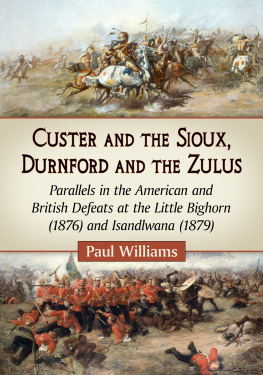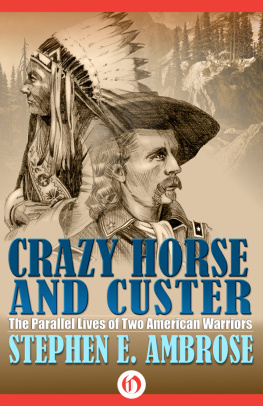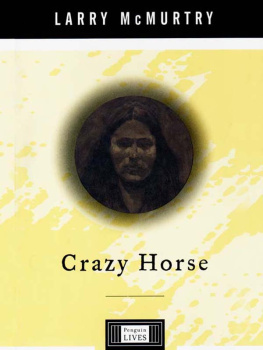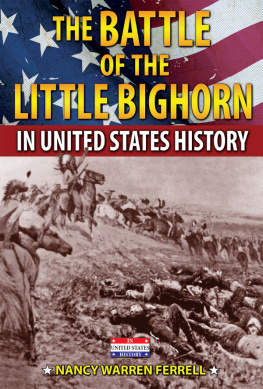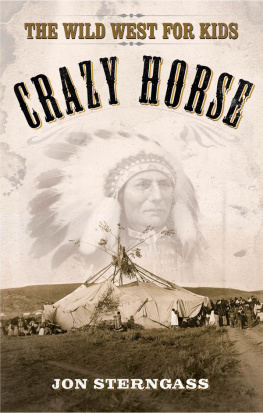Crazy Horse and Custer

The Parallel Lives of Two American Warriors
Stephen E. Ambrose

For Moira, who took me to Wounded Knee,
and for Stephenie, Barry, Andrew, Grace,
Hugh, Bib, and Blackness, who came along.
A WORD OF SPECIAL THANKS
To the Oglala Sioux at Pine Ridge and Wounded Knee, South Dakota; to the Brul Sioux at Rosebud, South Dakota; to the Shoshonis and Arapahoes at Wind River, Wyoming; to the Crows at Crow Agency, Montana; and to the northern Cheyennes at Lame Deer, Montana, for allowing me and my family to camp with them on their land;
and to the National Park Service officials at Gettysburg, Pennsylvania; Fort Laramie and Fort Phil Kearny, Wyoming; and Custer Battlefield, Montana, for their many kindnesses;
and to the state officials at Custer State Park in the Black Hills of South Dakota and at Camp Robinson, Nebraska, for their excellent campgrounds and generous assistance;
and to all the people of the Great Plains, red and white, for their hospitality.
CONTENTS
LIST OF PHOTOGRAPHS
LIST OF MAPS
INTRODUCTION
This is the story of two men who died as they livedviolently. They were both war lovers, men of aggression with a deeply rooted instinct to charge the enemy, rout him, kill him. Men of supreme courage, they were natural-born leaders in a combat crisis, the type to whom others instinctively looked for guidance and inspiration. They were always the first to charge the enemy, and the last to retreat.
Just as they shared broadly similar instincts, so did they have roughly parallel careers. Born at about the same time, they died within a year of each other. Both had happy childhoods, both had become recognized and honored leaders in their societies at an astonishingly young age (Custer at twenty-three, Crazy Horse at twenty-four), both were humiliated and punished at the height of their careers for violating the fundamental laws of their societies in an attempt to be with the women they loved, both recovered from the blows and re-established their claims to leadership roles, both had younger brothers who were even more daredevil risk takers than they were, and both were in a position when they died that, with a little luck, could have given them the supreme political direction of their people.
There were other parallels. Neither man drank. Both were avid hunters, for whom only the excitement of combat exceeded the joy of the chase. Each man loved horses, and riding at full gallop across the unfenced Great Plains of North America, day after day, was a source of never-ending delight for both of them.
Yet Crazy Horse and Custer, like their societies, were as different as life and death.
Crazy Horse and Custer spent their adult lives on the Great Plains, riding, hunting, fighting. They met only twice, on the battlefield, the first time on the banks of the Yellowstone in 1873, the second time on the banks of the Little Bighorn in 1876. The trail each man followed to the Little Bighorn is the subject of the following story.
Stephen E. Ambrose
Started in June 1971 at
Wounded Knee, South Dakota;
finished in July 1974 at
Camp Robinson, Nebraska.
I said, Does this mean that you will be my enemy if I move across the creek? Crazy Horse laughed in my face. He said, I am no white man! They are the only people that make rules for other people, that say, If you stay on one side of this line it is peace, but if you go on the other side I will kill you all. I dont hold with deadlines. There is plenty of room; camp where you please.
He Dog, close friend and associate of Crazy
Horse, in an interview in 1930
In years long-numbered with the past, when I was verging upon manhood, my every thought was ambitiousnot to be wealthy, not to be learned, but to be great. I desired to link my name with acts & men, and in such a manner as to to be a mark of honornot only to the present, but to future generations.
George Armstrong Custer
So much to win and only life to lose.
John Neihardt, The Song of the Indian Wars
* From The Song of the Indian Wars by John Neihardt. Copyright 1925; by Macmillan Publishing Co., Inc., renewed 1953 by John G. Neihardt. Reprinted by permission of Macmillan Publishing Company, Inc.
Part One

CHAPTER ONE
The Setting and the People: The Great Plains
As far as the eye could reach the country seemed blackened by innumerable herds [of buffalo].
Captain Benjamin Bonneville, 1832
Indians are so excessively indolent and lazy, they would rather starve a week than work a day.James Mackay, 1835
The Great Plains of North America, on a cloudless day, stretch out forever under an infinity of bright blue sky. During the violence of a tornado or a snowstorm, however, the vision is limited to the length of an arm. The Plains can be hot, dusty, brown, flat, and unfit for life; they can be delightfully cool, abundantly watered, a dozen shades of green, marvelously varied in appearance, ranging from near mountains to level valleys, and hospitable to all forms of life.
The Plains can be a source of endless delight, or of misery, as well they might be, considering their extent. They stretch from the Mexican border north to and beyond the Canadian frontier, from the 100 meridian west to the Rocky Mountains. The Plains are relatively flat, semiarid, and essentially treeless. In the midnineteenth century they were unfenced, covered by an endless sea of prairie grass, grass that sent its roots down twenty-four inches or more to withstand the droughts and which offered some of the most nutritious plant food in the world. Innumerable small streams cut through the Plains; many of them were dry beds in summer and only a few would be dignified by names or used as reference points in a humid area, but every one carried a name and a legend on the Plains. Trees, mostly cottonwoods, grew along the stream beds, and there men and animals tended to congregate. Among the cottonwoods they found shade, a little water, and perhaps an escape from the sense of limitless space, with its constant reminder of the insignificance of mankind.
Men and animals also congregated in the tree groves to escape the weather. The weather. On the Plains it cannot be ignored. There is, first of all, the nearly constant need for rain. The average yearly rainfall is less than twenty inches, so every storm is welcome. Or rather nearly every storm, because at times the sky can open, dump five inches of rain in a matter of hours, fill the stream beds to overflowing, and flood the surrounding countryside. Spring and summer storms often touch off tornadoes, too, which level everything in their path, or they become hail storms, beating plants to the ground and destroying them. No one can do anything about the stormsthose who live on the Plains must accept them.
They must also accept the wind, which blows harder, and more consistently, on the Plains than anywhere else on the continent, save at the seashore. And the average wind velocity on the Plains is equal to that on the seashore.
Does the wind blow this way here all the time? asked the eastern visitor.
No, mister, answered the cowboy. Itll maybe blow this way for a week or ten days, and then itll take a change and blow like hell for a while.
There are all kinds of winds on the Plains, winds from every direction, sometimes it seems from every direction at once. A chinook can roar over the mountains in the early spring and change the weather in minutes. There is a recorded case in South Dakota that only a Plainsman could believe: within three minutes of the arrival of the chinook the temperature rose from ten degrees below zero to forty-two degrees above zero. In the winter, blizzards reverse the processthe Plains are replete with stories of men working in their barns on a bright, fairly warm midwinter day who did not see the blizzard coming and who then got lost and froze to death trying to find their way from the barn to the farmhouse. In the summer the wind is hot, dry, and mostly from the south. Sometimes it kicks up a dust storm, with winds reaching eighty miles per hour. It always blows.


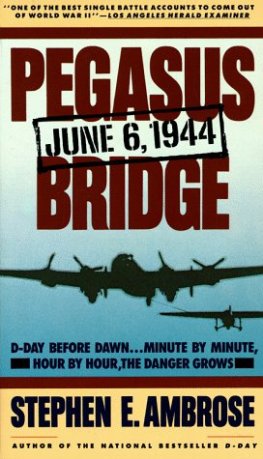
![Stephen Ambrose - Citizen Soldiers [Condensed]](/uploads/posts/book/457593/thumbs/stephen-ambrose-citizen-soldiers-condensed.jpg)


